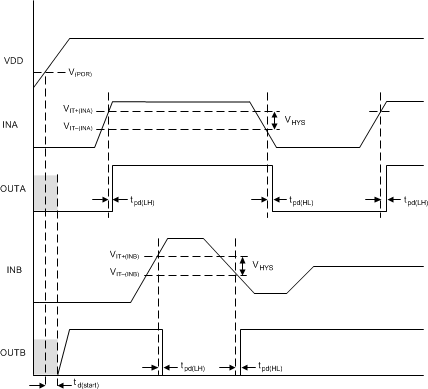SBVS240C November 2014 – February 2019 TPS3701
PRODUCTION DATA.
- 1 Features
- 2 Applications
- 3 Description
- 4 Revision History
- 5 Pin Configuration and Functions
- 6 Specifications
- 7 Detailed Description
- 8 Application and Implementation
- 9 Power Supply Recommendations
- 10Layout
- 11Device and Documentation Support
- 12Mechanical, Packaging, and Orderable Information
Package Options
Mechanical Data (Package|Pins)
- DDC|6
Thermal pad, mechanical data (Package|Pins)
Orderable Information
6.6 Timing Requirements
| PARAMETER | TEST CONDITION | MIN | TYP | MAX | UNIT | |
|---|---|---|---|---|---|---|
| .tpd(HL) | High-to-low propagation delay(1) | VDD = 24 V, ±10-mV input overdrive,
RL = 100 kΩ, VOH = 0.9 × VDD, VOL = 250 mV |
9.9 | µs | ||
| tpd(LH) | Low-to-high propagation delay(1) | VDD = 24 V, ±10-mV input overdrive,
RL = 100 kΩ, VOH = 0.9 × VDD, VOL = 250 mV |
28.1 | µs | ||
| td(start)(2) | Startup delay | VDD = 5 V | 155 | µs | ||
| tr | Output rise time | VDD = 12 V, 10-mV input overdrive,
RL = 100 kΩ, CL = 10 pF, VO = (0.1 to 0.9) × VDD |
2.7 | µs | ||
| tf | Output fall time | VDD = 12 V, 10-mV input overdrive,
RL = 100 kΩ, CL = 10 pF, VO = (0.9 to 0.1) × VDD |
0.12 | µs | ||
(1) High-to-low and low-to-high refers to the transition at the input pins (INA and INB).
(2) During power on, VDD must exceed 1.8 V for at least 150 µs (typical) before the output state reflects the input condition.
 Figure 1. Timing Diagram
Figure 1. Timing Diagram